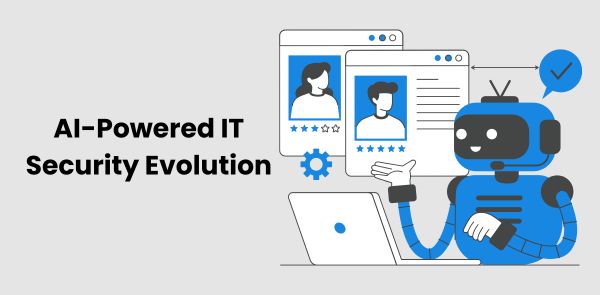
Introduction
As cyber threats become more sophisticated, IT security teams are under immense pressure to stay ahead of attackers. Traditional security measures alone are no longer sufficient to combat evolving cyber risks. This has led to the integration of Artificial Intelligence (AI) with IT security teams, creating a more proactive and intelligent defense mechanism. AI enhances cybersecurity by detecting threats faster, automating responses, and improving overall security posture. However, AI is not a replacement for human expertise—it complements security teams by handling vast amounts of data and identifying patterns that humans might miss. In this blog, we explore the convergence of AI and IT security teams, its benefits, challenges, and future trends.
How AI is Transforming IT Security
AI is reshaping IT security by improving the way threats are detected, analyzed, and mitigated. Here’s how AI is making an impact:
- AI-Powered Threat Detection and Response
AI-driven security systems use machine learning algorithms to analyze network traffic and identify suspicious behavior. Unlike traditional signature-based detection methods, AI adapts to new and evolving threats, making it more effective against zero-day attacks and advanced persistent threats (APTs). - Automated Security Analytics
AI can process and analyze massive amounts of security data in real time, identifying potential threats faster than human analysts. Security Information and Event Management (SIEM) solutions powered by AI enhance threat intelligence and provide actionable insights. - Predictive Threat Intelligence
AI doesn’t just react to threats—it predicts them. By analyzing historical attack patterns and real-time security data, AI can anticipate future threats, allowing IT security teams to implement preventive measures before an attack occurs.
Benefits of AI-Driven IT Security
The integration of AI into IT security teams offers numerous advantages:
- Faster Incident Response
AI can detect and respond to cyber threats in real time, reducing the time attackers have to exploit vulnerabilities. - Reduced False Positives
Traditional security systems often trigger a high number of false alerts. AI refines detection accuracy, ensuring security teams focus on real threats rather than wasting time on false alarms. - Enhanced Real-Time Monitoring
AI-powered systems provide continuous monitoring and instant analysis, ensuring a proactive security stance rather than a reactive one. - Automation of Repetitive Security Tasks
AI automates routine security tasks like log analysis, vulnerability scanning, and compliance checks, freeing up security professionals to focus on complex threats. - Scalability and Adaptability
AI-driven security solutions scale with organizational growth and adapt to new threats without requiring constant manual updates.
Challenges in AI Adoption for IT Security
Despite its advantages, integrating AI into IT security teams comes with challenges:
- Risk of AI Bias
AI systems rely on training data, and if the data is biased, the system may produce inaccurate threat assessments. - False Negatives and Over-Reliance on AI
While AI improves detection accuracy, it is not foolproof. Cybercriminals continuously evolve their tactics, and over-reliance on AI can create blind spots in security defenses. - Complex Implementation and Cost
Deploying AI-driven security solutions requires expertise, integration with existing infrastructure, and ongoing maintenance, which can be costly. - AI-Powered Cyber Attacks
Just as AI strengthens security, cybercriminals are leveraging AI to develop more sophisticated attacks, requiring security teams to stay ahead. - Regulatory and Ethical Concerns
The use of AI in cybersecurity raises ethical issues, such as data privacy concerns and compliance with global regulations like GDPR and CCPA.
The Role of IT Security Teams Alongside AI
AI is a powerful tool, but it cannot replace human intelligence. IT security teams play a crucial role in maximizing AI’s potential by:
- Interpreting AI-Generated Insights
AI can detect threats, but human expertise is needed to analyze and determine the best course of action. - Training AI Models for Accuracy
Security professionals help train AI models with quality data to improve accuracy and reduce biases. - Enforcing Compliance and Ethical Use of AI
IT security teams ensure AI-driven security solutions align with regulatory requirements and ethical standards. - Incident Response and Decision-Making
While AI can automate responses, complex security incidents require human decision-making and strategic intervention.
Future Trends in AI and IT Security
The convergence of AI and IT security teams is an ongoing process, with new advancements shaping the future of cybersecurity:
- AI-Powered Cybersecurity Automation
Organizations will increasingly rely on AI-driven automation to handle security tasks, reducing human workload. - AI-Driven Threat Intelligence Networks
AI will integrate with global security intelligence platforms, enabling real-time sharing of threat data and improved collaboration across organizations. - AI-Based Penetration Testing
AI-driven ethical hacking tools will simulate attacks and identify vulnerabilities more efficiently than traditional penetration testing methods. - Advanced AI-Driven Authentication
AI will enhance identity verification through behavioral biometrics and adaptive authentication techniques. - Regulatory AI Governance Frameworks
Governments and industry regulators will establish guidelines to ensure responsible AI use in cybersecurity.
Conclusion
The convergence of AI and IT security teams is revolutionizing cybersecurity. AI enhances threat detection, automates responses, and provides predictive insights, but human expertise remains essential. A balanced approach—where AI and IT security professionals collaborate—ensures robust, proactive security defenses. As AI technology continues to evolve, organizations that leverage its capabilities while maintaining a strong human oversight will be best positioned to combat the ever-growing cyber threats of the future.
